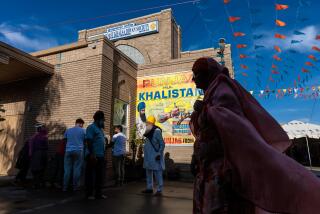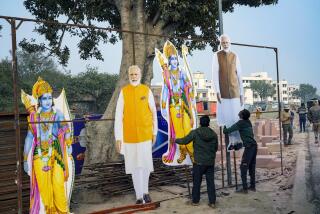Embattled Kashmir is getting back on tourists’ radars
The signs that greet you as you emerge from the little airport in Srinagar, Kashmir’s main city, give you a sense of how unexpected the place is going to be. The first one I saw advised, “Do not get your daughter married before the age of 18. (It is a criminal offence.) Education first. Marriage afterwards.”
I began bumping into town, and a policeman’s kiosk announced, “Enjoy your stay in the valley. You are safe in our hands” — one of those assertions of security likely only to heighten your sense of insecurity.
When Kashmir was a haven for Western honeymooners and lotus-eaters in the 1980s, Srinagar welcomed two flights a day if it was lucky. Quite wonderfully, about three dozen flights a day now come here. Still, in a week of sightseeing recently, I encountered only a handful of foreign visitors around Srinagar, yet 1.3 million Indian tourists flocked to Kashmir last year, rediscovering a place that has long been renowned for its mountains, valleys and gardens.
After more than 20 years of having been associated mostly with curfews and fighting, Kashmir is on its way to becoming a hot destination again.
The mountainous region in northwest India, bordering China, Tibet and Afghanistan, has long been a target for foreign incursions, but its most recent problems began after India and Pakistan were divided in 1947, and each thought it had a reason to claim it.
Pakistan controls the rugged northern part of Kashmir, but the fairy-tale valley surrounding Dal Lake remains in Indian hands, and more than half a million Indian troops have been trying to keep the peace in the predominantly Muslim state for the last quarter-century. As locals rise up against what they see as an occupation, more than 70,000 people have lost their lives violently since 1989.
But in November 2012, the British Foreign Office followed Germany and Japan in declaring it was safe for tourists to return to the region — the U.S. State Department remains cautious — so for now you can enjoy gorgeous new amenities in an area that is only now being rediscovered.
The Taj Group opened Vivanta, a chic glass-filled hotel above Dal Lake, in 2011, and another rambling space, the Lalit Grand Palace, is set in a maharajah’s palace.
Best of all, last year saw the opening of Sukoon, Kashmir’s first “luxury houseboat,” where guests can enjoy superb gourmet meals while slipping into a lulling rhythm in which days are spent watching gondolas drift beside a lotus pond and shopping means a slow paddle to a grocery above the reeds.
Before Sukoon, all the 2,000 or so houseboats on Srinagar’s Dal and Nageen lakes were divided into two categories, “A” and “Deluxe” (often rebranded as “Super Deluxe”), which meant that every one of them claimed top status, and none deserved it.
Exotic combinations
For me, the great beauty of setting foot in Srinagar was finding echoes of many of the exotic sights of central Asia. In a combination you’ll find nowhere else, blue-eyed girls walk among white-bearded old men in skullcaps to pagoda-like mosques, which look like nothing so much as Katmandu made over by Afghans.
Tibetan Muslims share thukpa (noodle soup) and momos (dumplings) with their Kashmiri neighbors along the twisting alleyways of the old town. Tidy, flower-ringed Cotswold-style cottages sit among Hindu shrines and crumbling, two-story wooden houses.
And above a tiny, deserted “7-D Entertainment Centre,” a tethered helium balloon carries giggling riders, as in some “Monty Python” cartoon, every one of its passengers receiving tickets bearing the legend, “Break down fear. Relief is here.”
Yet the most piquant presence, tucked among the riverine landscapes and apple trees, is that of the British, who never exactly ruled Kashmir but who used to come here in battalions in the summer from their capital in Delhi. (The houseboat system began because Brits were not allowed to buy houses on land, so they enterprisingly snapped them up on the lakes instead.)
All India is an aromatic time capsule of Victorian and Edwardian attitudes: a muddle of cantonments and billiards tables and yellowing P.G. Wodehouse books for sale on the pavement outside the cricket ovals. But in Kashmir the spell is especially great precisely because time here has been under house arrest for decades. While skyscrapers and shopping malls shoot up in Mumbai and Bangalore, India, Kashmir remains more or less forgotten, stuck in the tensions and debates of 1947.
One day, Ghulam Butt invites me for tea on his grand English lawn and keeps up a smiling and elegant repartee even though, four days before, he lost his wife of 63 years. He remembers when George Harrison and Ravi Shankar, staying on the legendary Butt’s Clermont Houseboats, played a concert on the lawn; he reminisces about Mountbatten’s grandchildren and Michael Palin (and V.S. Naipaul, who stayed for a long stint in Butt’s father’s time).
In 1995, the army took over his garden and barred him from his property, he says, when there was a monthlong siege at nearby Hazratbal Mosque.
But “the last three years have been better,” he assures us, even though the number of his houseboats has fallen from nine to five. When we leave, he stands erect in his driveway and, eyes wistful from his loss, gives us a crisp, upstanding British military salute.
Kashmir is full of such rich poignancies, the strangeness of a London suburb remade at 5,000 feet, in the shadow of some of the world’s highest mountains. I step into Mallinson Girls School, in the center of Srinagar, and the Englishman I’m traveling with announces, “A prep school!” He couldn’t be more right: Shakespearean cottages with green roofs stand above perfectly trimmed gardens, and one awaits only a Volvo to carry Charles and Lucinda home.
Next door to the school is Tyndale-Biscoe, the Eton of Srinagar — you hear its name again and again from proud graduates — named after a 19th century missionary named Canon Cecil Tyndale-Biscoe, who ended up teaching in Kashmir after studying theology at Cambridge.
As Brigid Keenan tells it in her indispensable “Travels in Kashmir,” the area was so wild then that bands of pimps would sometimes swoop onto the playing fields and abduct pretty boys to be forced into prostitution. Tyndale-Biscoe duly taught his boys boxing, led them into good deeds and firefighting around the city and, if a boy was seen reading a dirty book, literally had him munch through its pages.
Across the street, through a small green door, usually locked, we step into a riot of overgrown weeds, the Christian cemetery, whose fresh white crosses all bear Indian (or perhaps Anglo Indian) names.
Walk through to a deeper section, though, and you’re in the midst of Lavinias and “Mabel Emily, a darling wife,” surrounded by stones “erected by the Officers of the 40th Regiment” and others that recall “Granville William Richard Howard-Vyse, Major R.A.” One of them even remembers Robert Thorp, the half-English, half-Kashmiri who spoke out on behalf of Kashmiri independence in 1868 and was killed, age 30, for his efforts.
Back out in the street, I pass one old fogy under a solar pith helmet, walking with his memsahib along the bund; no one told them, perhaps, that Paul Scott’s “Staying On” is 36 years behind us.
Not far away, a yellow school bus with “Eternal Public School” written on its sides rattles past Suffering Moses, the shop set up in 1840 that my mother recalls visiting as a girl (though, like the great chronicler of Empire Jan Morris, she remembers it as Holy Moses). The name, of course, came from its loyal British patrons, but its gorgeously intricate papier-m¿¿ché continues to dazzle 170 years on.
There are signs of agitation in Kashmir if you wish to find them; the issue of independence remains unresolved, and most weeks bring reports of fresh skirmishes, usually out in the countryside far from tourist sights. The presence of 600,000 Indian soldiers surely does as much to stir up angry feelings as to subdue them.
At one ghat along the Jhelum River, someone has scrawled, in huge black letters, “Gaza” and “Al-Jihad” and even “Welcome Taliban.” Among the houseboats on the lake, which tend to revel in tea-cozy names that extol the royal family or more recent foreign ones (“Jamaica,” “Haifa,” “Bob Marley”), you will now find “Iraq” and, as if in answer, “Texas” and “New Texas.”
One day, I try to look in on the site known as Jesus’ Tomb, in central Srinagar. I walk down a little back street toward it, and suddenly a young tough appears and blocks my way. Within seconds, men are approaching from every direction, on foot, on scooters, gesturing. The boy who blocks me pulls out his cellphone. Others start shouting, trying to wrench away a camera.
It’s small consolation to learn that even the Kashmiri director of tourism was harassed here by young Muslims who feel that outsiders are intruding on their turf, and, by associating a Muslim shrine with Jesus, trying to claim the area as their own.
Other than that, though — and for all the reports of confrontations I read after I returned home — Kashmir is as calm and peaceful a place as I can remember visiting, especially on the lake, in a different universe from what I’d expected, let alone from the streets of Jerusalem or Phnom Penh, Cambodia, or, for that matter, central Washington, D.C.
Indeed, the seven or eight checks and scans I must go through while leaving the area — I even have to show my boarding pass on arrival in Delhi from Kashmir — have the wonderful if quite unintended effect of suggesting that it’s Kashmir, for tourists, that is the secluded sanctuary; the rest of the world is what can sometimes feel like a war zone.
More to Read
Sign up for The Wild
We’ll help you find the best places to hike, bike and run, as well as the perfect silent spots for meditation and yoga.
You may occasionally receive promotional content from the Los Angeles Times.






